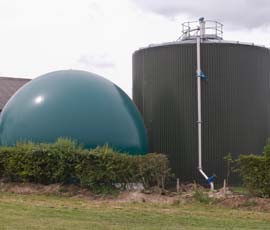Dairy Event 2011: Dedication needed to make AD pay

The viability of farm-scale anaerobic digestion plants is still fairly marginal, despite the recently increased Feed-in Tariff. So how do you decide whether AD is right for you? Paul Spackman finds out
Many experts liken anaerobic digesters to a giant cow’s rumen, which needs constant managing in exactly the same way as any ruminant. An understanding of these processes is therefore an obvious advantage, but so too is a passion to make systems work, according to Dorset dairy farmer and Biogas Nord’s Owen Yeatman.
“AD is not really suitable if you’re just looking to become more self-sufficient in energy. It needs to be viewed as another farming enterprise in its own right and so needs the appropriate commitment and enthusiasm.
“For dairy farmers, biogas is a good opportunity to use their existing skills base to step sideways away from milk production and give more stability and diversity to the business.”
Mr Yeatman acknowledges the increased Feed-in Tariffs (FiTs) are less than many need to make projects viable, but urges farmers to look at the longer-term returns, especially as FiTs are index-linked, and so guaranteed to increase annually. “You can’t say the same for any other farm outputs, especially milk.”
When assessing any new venture it is therefore worth looking at the projected income growth over five, 10 or 20 years, compared with costs, which are unlikely to change significantly, he says. “Even growing costs aren’t likely to change dramatically, as you’ll probably use the digestate on-farm, which will reduce exposure to fertiliser costs.”
Feedstock
Feedstock type, availability and security of supply is a major factor in any project and can determine the type of technology employed, says Cath Anthony from Bidwells. “It’s important to look at biogas yield a hectare compared with how much that’s costing you to produce. Maize normally has the highest biogas yield, but grass may be more appropriate for your farm. AD is very site specific.”
Security of feedstock supply is essential and banks will be keen to see this has been accounted for before granting funding.
“No-one’s going to finance a plant in the current climate without assurances about feedstock,” says Bill Elliot, from organic waste management company Envar.
“Financiers will look for feedstock supply contracts that cover the period of their risk and many banks will want at least two years beyond the final date you will pay them off.”
It is worth talking to banks, planners and the local community early on in the project to make sure they understand what you are doing and why, Ms Anthony adds. “It can be a good way of allaying any fears and potential problems.”
Digestate
Making sure you have enough land available to spread digestate is another key consideration, as about 90-95% of the volume of original material will come out as digestate.
More than 150,000t of digestate is currently going on to UK farmland, and ensuring the quality of the end product is vital, says Brian Chambers, of ADAS.
Where food waste is used as a feedstock, it may be worth installing a pasteurisation system for digestate to effectively control pathogens and minimise any food safety risks for following crops or livestock where digestate is spread.
Ensuring digestate meets quality protocols such as PAS110 can help “get around the hassle of environmental permitting” but extra costs may be incurred in the process, he says.
Crop-based feedstocks may cause fewer potential issues with the digestate, but farmers still need to consider wider implications on the existing system, he adds. For example, using maize-based feedstocks and digestate could potentially increase fusarium risk for following cereal crops.
When assessing any biogas system, it is important to account for the nutrient value of digestate, in terms of fertiliser savings, Mr Yeatman says.
He says his fertiliser bill has been cut by three-quarters over the three years since starting up a 370kW single stage digester, running on 8,000t cattle slurry/manure and 3,500t of maize/grass silage a year.
Typical nutrient composition of the digestate is 5.7kg/m3 nitrogen, 1.7kg/m3 phosphate and 3.2kg/m3 potash.
“Nitrogen is also more readily available and there aren’t any issues with putting it on fresh grassland. It injects more easily and doesn’t kill the clover like fertiliser does,” he adds.
Feed-in Tariffs
The Feed-in Tariffs scheme was introduced on 1 April 2010 in a bid to drive the uptake of renewable energy.
Rates for anaerobic digestion were reviewed as part of a fast-track review earlier this year. This means that from 1 August, FiTs for anaerobic digestion will increase to: ≤250kW – 14p/kWh; >250kW-≤500kW – 13p/kWh. Payments are index-linked and guaranteed for 20 years.
As of 1 April 2010, microgenerators (50kW capacity or less) in renewable technologies supported through FiTs (AD, hydro, solar and wind) will not be able to claim Renewables Obligation Certificates (ROCs).
Installations with a capacity greater than 50kW, or installations of any capacity in technologies not covered by FiTs, will still be eligible to apply for support through the Renewables Obligation. Installations over 5MW can only claim ROCs as FiTs are not available.
It’s important to look at biogas yield a hectare compared with how much that’s costing you to produce
dairynews
